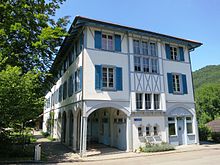Albisbrunn Foundation
The Albisbrunn Foundation in Hausen am Albis , Canton of Zurich , Switzerland is a youth home for young people with abnormal behavior. The foundation consists of group houses that offer young people living space, an in-house school, various craft businesses, a swimming pool and many employment opportunities.
history
The Albisbrunn Foundation was founded in 1924 by Alfred Reinhart (1873–1935) and, according to the foundation charter, is intended to «children, adolescents and younger adults [...] whose mental development and upbringing is hampered by individual and social factors that are dependent on the current state of science and Let pedagogical practice provide possible help ». The former Kurhaus of the cold water sanatorium Albisbrunn including 34 hectares of park in Hausen am Albis was donated by the Alfred Reinhart family . In the autumn of 1851 Richard Wagner had spent two months there, where he hoped to cure his ailments (facial rose, nettle rash, chronic intestinal upset) and where his conception of the Ring of the Nibelung came about. The Kurhaus was completely renovated and rebuilt. In the course of time, further renovation measures led to the now existing diverse infrastructure for residential, school and training purposes.
Country Education Home Albisbrunn
The "Landerziehungsheim Albisbrunn" is a reform home for male adolescents. Albisbrunn shaped the Swiss home history. Over the course of time, the focus, age groups, occupancy numbers, apprenticeships, management styles and of course the pedagogical principles changed.
Albisbrunn was shaped by the educational psychology of Heinrich Hanselmann . He ran the house from 1924 to 1929. At the same time he founded the curative education seminar in Zurich, a teacher training center. In 1931 he became the first professor for curative education in Zurich.
Further home directors were: 1930–1953 Max Zeltner, 1953–1956 Anny Zeltner, 1956–1961 Dr. Kurt Meyer.
In 1931 an observation station was opened. The curative education teacher Paul Moor , later professor for curative education in Zurich, took over the management . He also wrote the standard work "Heilpädagogik", which had a lasting impact on the work in Albisbrunn:
“ We have to understand the child before we raise it ... Wherever a child fails, we don't just have to ask: What do you do about it? Pedagogically more important is the question: What do you do for it? Namely for what should and could become ... We never only have to raise the developmentally inhibited child as such, but always also his environment ... All who have no inner support need people who in turn have an inner support, as an outer hold. This can consist of structures, joie de vivre, help with shaping your life and coping with everyday life .
Not against the mistake, but for what is missing [..] and it should be and remain one of the most important principles of curative education not only to combat the symptoms and to eliminate them quickly (just as the doctor does not directly address the red spots with measles ), but rather to heal the child by doing everything to make him feel better .
Not only the child, but also those around him must be educated. "
In 1949, Moor took over the curative education seminar from Hanselmann and in 1951 the chair for curative education.
1961–1989 Hans Häberli was the home manager of Albisbrunn. Since the adolescents had on average already five placements outside of their family behind them before the induction, it was a goal to offer a network of relationships that was as constant as possible. This was achieved through an unusually long period of employment of the approximately 90 employees who were able to live in Albisbrunn or in the surrounding communities. The group concept was introduced in the 1970s. The young people should be looked after by a couple in small groups. Several group houses were built for this purpose.
In 1989, Heinz Bolliger took over the management of the home, having previously worked in the home for 26 years, most recently as head of education and deputy director of the home. From 1978 to 1986 he was mayor of Hausen am Albis . He headed Albisbrunn until 1998. From 1998–2006 Bastian Nussbaumer was the home manager, since 2006 Ruedi Jans.
Albisbrunn toys
Wooden toys from Albisbrunn have been part of everyday life in many kindergartens and families in Switzerland for generations. They were produced by hand and painted with harmless colors and glazes. The toy production in the carpenter's workshop was part of the training and employment of the young people, who were also able to earn their pocket money with it.
Vocational training and manufacturing companies
In the beginning, the kitchen and agriculture offered employment and training opportunities. The carpenter became famous through the Albisbrunn wooden toys. The foundation has its own, now ISO -certified production facilities ( ISO 9001: 2008 ), in which apprentices are trained: construction, painting, mechanical engineering, metal construction, carpentry, printing and advertising technology. The professionally managed businesses offer comprehensive services from advice to production and implementation and a large selection of quality products.
In 1945 the self-publishing house Albisbrunn was founded, which published educational textbooks.
criticism
In 1996 the foundation came under criticism of the Verein gegen Tierfabriken Schweiz , which accused it of cruelty to animals : several calves were not kept in a species-appropriate manner. The agricultural business of the Albisbrunn Foundation was completely closed in 2000 - not because of the allegations raised, but for educational and economic considerations.
Web links
Individual evidence
- ^ Hermann Alfred Reinhart * October 16, 1873 Winterthur, † August 26, 1935 Hausen am Albis
- ↑ The first donation was 400,000 francs [1]
- ^ Heinrich Hanselmann: Introduction to curative education . Erlenbach-Zurich; Leipzig: Rotapfel, 1930
- ↑ State Archives: Landerziehungsheim Albisbrunn
- ^ Paul Moor: Curative Education. An educational textbook . (1965) Huber, Bern [u. a.] 1974
- ↑ Change of home manager 1989: Bolliger takes over from Häberli

